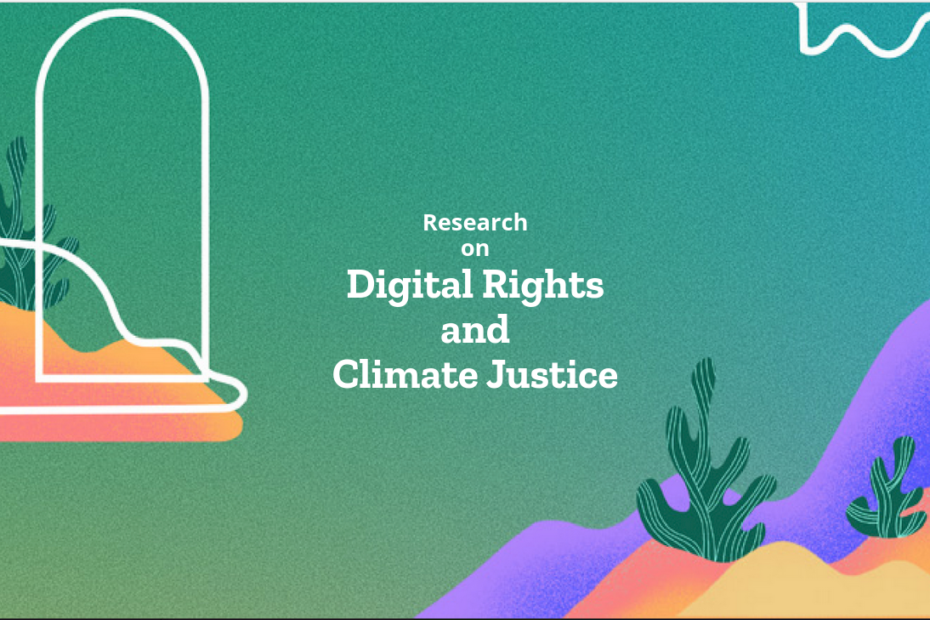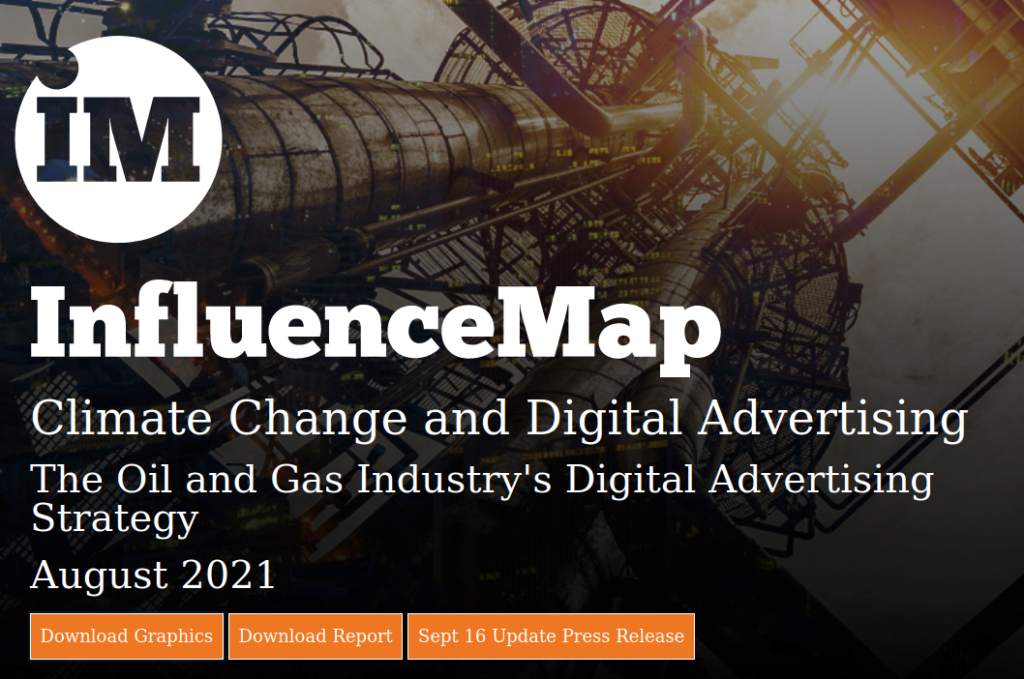
In 2021 Ford, Mozilla and Ariadne launched a research project to better understand what responsible grantmaking on the intersection between digital rights and climate/environmental justice could look like. In July 2022, we proudly presented 8 new pieces of research on this theme.
The Engine Room created a landscape analysis as the key research partner in this project. We also published seven issue briefs by the Association for Progressive Communications (APC), BSR, and the Open Environmental Data Project and Open Climate.
In this article I offer a preview of what you can expect from these different pieces of research. With the links below, you can jump to a specific report summary:
Landscape mapping – The Engine Room Gaps for joint actions between environmental and digital rights movement – APC Interplay between internet and environmental governance – APC Extractivism, mining and technology in the global South – APC The impact of disinformation on environmental movements – APC Climate justice and the knowledge commons – Open Environmental Data Project and Open Climate Where environmental justice, climate justice and digital rights meet – Open Environmental Data Project and Open Climate Climate misinformation – BSR
Landscape Mapping
The Engine Room report At the confluence of digital rights and climate & environmental justice: A landscape review provides an overview of how an extremely diverse set of communities and movements work across the intersection of climate justice and digital rights. Why should you read it?
A recurring theme in discussions I have had on climate and tech is that people feel they do not know where to start. This report is a great place to start as it offers an accessible and thoughtful overview into different climate and environmental justice issues that emerge from technological innovation. The Engine Room specifically outlines five issue areas;
- the environmental toll of digital infrastructures;
- access to information and climate disinformation;
- climate monitoring;
- increased surveillance of environmental activists and land defenders;
- migration justice.
Next to these five issue areas the report offers insight into cross-cutting themes and challenges. Take for example the reports section on the need for a shared worldview between communities, movements and sectors. Here the Engine Room acknowledges that the climate justice and digital rights movement have different languages, histories and entry points into issue on climate and tech, but connect working towards an intersectional lexicon to more fundamental ideological differences. They found that within and between the movements there are different ideas on how to define and address injustices, and the movements have distinct and conflicting views on the role of the state and market in addressing harms and fostering solutions.
Issue briefs
1. Mapping the gaps between digital rights and environmental justice actors in the global South
APC issue brief dives into the gaps between the digital rights and environmental justice movement. They argue that digital rights involvement in climate issues to this day has been ad-hoc and focused on isolated issues rather than as a core strategic concern. They identify four important gaps that limit joint action:
- Awareness of each other’s advocacy terrains.
- Different relationships to power.
- A general absence of cross-over advocacy concerns as core strategic agendas
- Gaps in capacity building: Evidence of low-hanging fruits
All four gaps are worth elaborating on, but my Aha moment when reading this issue brief was on the different relationships to power. Here APC refers specifically to the relationship with the private sector. Environmental groups have adversarial and contested relationships to agribusiness, energy and other extractive sectors, while some digital rights organizations collaborate with Big Tech or Big Tech on digital rights. Any meaningful action on the intersection on climate and tech thus requires a clear articulation of the relationship with the market.
The issue brief ends with avenues where the relationship between digital rights and environmental justice actors in the Global South could be strengthened.
2. Environmental and digital rights: Exploring the potential for interplay and mutual reinforcement for better governance
This issue brief by APC explores what those working in the internet governance sphere can learn from governance debates on environmental issues. The deep dive highlights the commonalities between the governance issues: global in scope, the need for action of market, state and citizens in management and protection, cross-cutting policy areas, and exercising key rights. They translate these commonalities into governance questions that still need to be addressed.
What allowed me to ground their argument was the example of applying environmental law to regulate the environmental harms of the internet infrastructure. In this blog post I write about the impact of data centres beyond carbon and how these infrastructures are increasingly becoming a focal point for conflict over land, water and energy.
APC asks if would it be possible, using the Aarhus Convention, to demand more information on the massive natural resource dependency of data centres, the environmental cost of using and manipulating data, and the projections of greenhouse gas emissions from our use of technology?
3. Extractivism, mining and technology in the global South: Towards a common agenda for action
This third APC issue brief clearly explains the challenges and conflicts around the mining of natural resources needed tech hardware, what they refer to as extractivism. It offers clear examples of the harms in the DRC, in Mexico and Brazil, and in the Lithium Triangle in Chile, Argentina and Bolivia.
They deliberately use a broad definition of extraction to include both rare metals and minerals needed for digital devices and the consumption of another natural resource, such as water in both the mining and the data process. This framing is important as it will allow digital rights actors to connect the environmental tool so the internet to the broader profit-driven extractivist approach of the technology sector.
“Extractivism” in the context of this brief refers to the formal and informal mining of minerals used in the production of technology in the global South.
APC
4. Addressing the impact of disinformation on environmental movements through collaboration
The fourth and final issue brief presented by APC engages with how the operations of disinformation/hate speech and the data economy impact the discourse on climate information and the safety and security of the environmental researchers, NGOs and activists.
The issue brief highlight how a paid speech by the fossil fuel industry is a problem. Not only do social media companies continue to receive ad revenue from disseminating climate disinformation, but the study conducted by InfluenceMap also shows how these post spread. The influence map found that in the United States, 25,147 Facebook ads with misleading “greenwashing” messages from just 25 oil and gas organisations were seen over 431 million times.

5. Climate Justice & the Knowledge Commons: Opportunities for the digital rights space
When looking at the intersection of climate and tech there is a tendency to look for answers by looking towards the future or at the work, other movements are doing. In this deep dive into the knowledge commons the Open Environmental Data Project and Open Climate argue that we also need to look at our own histories and the values that have shaped the digital rights movement to find avenues of cooperation.
The digital knowledge commons will be a critical space for facilitating communication about, and collaboration around, climate action. Resources are needed, however, to ensure these spaces remain accessible and inclusive, and that they don’t perpetuate existing social injustices.
Evelin Heidel, Shannon Dosemagen and Katie Hoeberling
Drawing from their own experiences working at the intersection of the climate and open movements they highlight five areas where digital rights groups can collaborate with climate justice activists:
- Addressing misinformation around climate change on social media platforms, especially in
languages other than English, and in countries other than the U.S. and Europe. - Understanding how intellectual property might act as a barrier to knowledge about the
climate crisis or for the deployment of climate solutions. - Building a linguistically, geographically, and socially diverse knowledge commons with open
tools that can address important knowledge gaps on climate change information, including
climate crisis responses. - Exploring new future narratives to build a common path towards a better Internet: more just,
inclusive, and equitable. - Using a climate lens to analyze digital rights issues, such as privacy, surveillance or artificial
intelligence, and understanding how climate change might impact digital rights
6. Environmental Justice, Climate Justice, and the Space of Digital Rights
In this issue brief the Open Environmental Data Project and Open Climate explore the different histories of the climate justice and environmental justice movement (from US vantage point). This deep dive came about after the authors noted that we (the initiators of the broader research project) used the terms climate and environmental justice interchangeably. They argued that in order to be responsible grantmakers, we need to be aware of the distinct histories and struggles that shaped these two movements.
This issue brief is an important read for those who want to learn more about the differences and commonalities of the climate justice and environmental justice movements and where digital rights issues may intersect. They specifically identify three areas:
- The relationship between the surveillance state, environmental activists, and the right to privacy
- Climate migration and the right to migrant privacy and protection
- The ability to use, collect and understand environmental data
What I enjoyed reading were the examples the authors used to illustrate that not all people affected by climate crisis are affected equally, and how not all environmental issues should be collapsed under climate justice, even if climate justice is intimately connected to environmental justice.
7. Building a High-Quality Climate Science Information Environment: The Role of Social Media
BSR argues that a healthy information environment is crucial in fighting the climate crisis, and offers a deep dive into the issues around climate misinformation. If you are interested in learning more about climate misinformation and why social media platform responses have been lacking, this is the issue brief for you. It starts by unpacking climate misinformation and the different ways it manifests on social media and changes over time. The report then offers a good analysis of how social media platforms ‘traditionally’ deal with misleading or harmful content on their platforms, and why their responses to the climate misinformation have been lacking. They conclude with recommendations for social media platforms, civil society, and digital rights funders.
None of the major social media platforms include climate change in their misinformation policies, implying that they do not view climate misinformation as something that is likely to lead to physical harm, especially imminent physical harm. As a result, platforms currently do not remove climate misinformation from their platforms.
BSR

